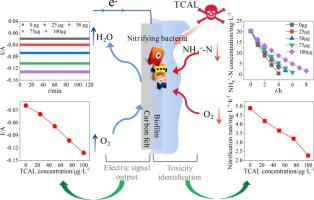Bioelectrochemistry ( IF 4.8 ) Pub Date : 2022-04-22 , DOI: 10.1016/j.bioelechem.2022.108142 Heng Wu 1 , Mengyao Cui 2 , Xu Yang 2 , Yiliang Liu 2 , Jingting Wang 2 , Lixia Zhang 2 , Guoqiang Zhan 2 , Yihua Zhao 3

|
In this work, a toxicity monitoring microbial system (TMMS) with a nitrifying biofilm as a sensing element and cathode oxygen reduction as an electrical signal was successfully constructed for trichloroacetaldehyde (TCAL) detection. The current and nitrification rate showed a linear relationship with TCAL concentration from 0 to 100 μg/L (R2current = 0.9892, R2nitrification = 0.9858), indicating that the target substrate concentration can be directly obtained from an electrical signal without further sample concentration. High-throughput sequencing revealed that the TMMS was composed of autotrophic/heterotrophic nitrifying and denitrifying microorganisms. Further analysis via a symbiotic relationship network demonstrated that unclassified_Comamonadaceae and unclassified_Xanthobacteraceae were the core nodes for maintaining the interaction between autotropic and heterotrophic nitrifying bacteria. Kyoto Encyclopedia of Genes and Genomes analysis showed that the electron transfer process primarily relied on ferredoxin and cytochromes under TCAL stress, and the abundance of functional enzymes involved in the process of nitrification was decreased, resulting in changes in electrical signal output. This work explored a visual signal sensor combined with electrochemistry and autotrophic/heterotrophic nitrification, which provided new insights into recognition and response mechanisms for microbial monitoring of toxic substances.
中文翻译:

视觉信号传感器耦合硝化作用可持续监测三氯乙醛及其响应机制
在这项工作中,成功构建了以硝化生物膜为传感元件,阴极氧还原为电信号的毒性监测微生物系统(TMMS),用于三氯乙醛(TCAL)检测。电流和硝化速率与 TCAL 浓度呈线性关系,从 0 到 100 μg/L(R 2电流 = 0.9892,R 2硝化 = 0.9858),表明目标底物浓度可以直接从电信号中获得,无需进一步样品专注。高通量测序显示TMMS由自养/异养硝化和反硝化微生物组成。通过共生关系网络的进一步分析表明,unclassified_comamonadaceae和unclassified_xanthobacteraceae是维持自养和异养硝化细菌相互作用的核心节点。京都基因与基因组百科全书分析表明,TCAL胁迫下电子传递过程主要依赖铁氧还蛋白和细胞色素,参与硝化过程的功能酶丰度降低,导致电信号输出发生变化。这项工作探索了一种结合电化学和自养/异养硝化的视觉信号传感器,为微生物监测有毒物质的识别和响应机制提供了新的见解。









































 京公网安备 11010802027423号
京公网安备 11010802027423号